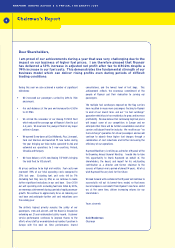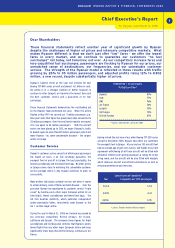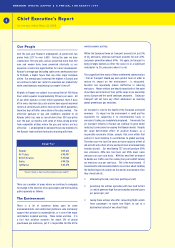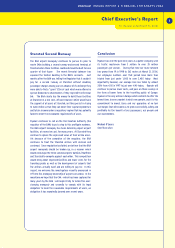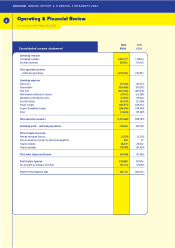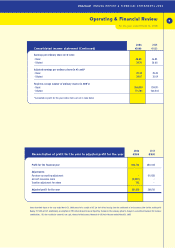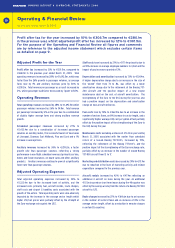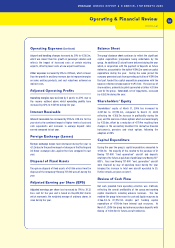Ryanair 2006 Annual Report Download - page 14
Download and view the complete annual report
Please find page 14 of the 2006 Ryanair annual report below. You can navigate through the pages in the report by either clicking on the pages listed below, or by using the keyword search tool below to find specific information within the annual report.
Critical Accounting Policies (Continued)
In accounting for long-lived assets(principally aircraft and
related parts), Ryanair must make estimates about the
expected useful lives of the assets, the expected residual
values of the assets and the potential for impairment based on
the fair value of the assets and the cash flows they generate.
In estimating the lives and expected residual values of its
aircraft, Ryanair has primarily relied on industry experience
and recommendations from Boeing, the manufacturer of all of
the company's owned aircraft. Subsequent revisions to these
estimates, which can be significant, could be caused by
changes to Ryanair's maintenance program, changes in
utilization of the aircraft, governmental regulations on ageing
of aircraft and changing market prices for new and used
aircraft of the same or similar types. Ryanair evaluates its
estimates and assumptions in each reporting period, and when
warranted adjusts these assumptions. Generally, these
adjustments are accounted for on a prospective basis, through
depreciation expense.
Ryanair periodically evaluates its long-lived assets for
impairment. Factors that would indicate potential impairment
would include, but are not limited to, significant decreases in
the market value of aircraft, a significant change in an
aircraft’s physical condition, and operating or cash-flow losses
associated with the use of the aircraft. While the airline
industry as a whole has experienced many of these factors
from time to time, Ryanair has not yet been seriously impacted
and continues to record positive cash flows from these long-
lived assets. Consequently, Ryanair has not yet identified any
impairments related to its existing aircraft fleet. The company
will continue to monitor its aircraft and the general airline
operating environment.
An element of the cost of an acquired aircraft is attributed on
acquisition to its service potential, reflecting the maintenance
condition of the engines and airframe. Additionally, where
Ryanair has a lease commitment to perform aircraft
maintenance, a provision is made during the lease term for this
obligation. Both of these accounting policies involve the use
of estimates in determining the quantum of both the initial
maintenance asset and/or the amount of provision to be set
aside and the respective periods over which such amounts are
charged to income. In making such estimates, Ryanair has
primarily relied on industry experience, industry regulations
and recommendations from Boeing; however, these estimates
can be subject to revision, depending on a number of factors,
such as the timing of the planned maintenance, the ultimate
utilization of the aircraft, changes to government regulations
and increases and decreases in the estimated costs. Ryanair
evaluates its estimates and assumptions in each reporting
period and, when warranted, adjusts these assumptions, which
generally impact on maintenance and depreciation expense in
the income statement, on a prospective basis.
Treasury Policy, Fuel, Currency and
Interest Rate Risk Management
The Audit Committee of the Board of Directors has
responsibility for setting the treasury policies and objectives
of the group which include controls over the procedures used
to manage the main financial risks arising from the group’s
operations which comprise of commodity price, foreign
exchange and interest rate risks. The group uses financial
instruments to manage exposures arising from these risks.
These instruments include borrowings, cash deposits and
derivatives (principally jet fuel derivatives, interest rate swaps
and forward foreign exchange contracts). It is the group’s
policy that no speculative trading in financial instruments
takes place.
The group’s historical fuel risk management policy has been to
hedge between 70% and 90% of the forecasted rolling annual
volumes required to ensure that the future cost per gallon of
fuel is locked in. This policy was adopted to prevent the group
being exposed, in the short term, to adverse movements in
world jet fuel prices. However, when deemed to be in the best
interests of the group, it may deviate from this policy. In more
recent times, due to fundamental changes in the
world fuel markets, the group has adopted a more short term
and strategic approach to fuel hedging. At August, 2006 the
group had hedged 90% of its fuel exposures for the period
June to December 2006 inclusive.
Foreign currency risk in relation to the group’s trading
operations largely arises in relation to non-Euro currencies.
These currencies are primarily Sterling pounds and US dollar.
The group manages this risk by matching Sterling revenues
against Sterling costs. Any unmatched Sterling revenues are
used to fund forward foreign exchange contracts to hedge US
dollar currency exposures that arise in relation to fuel,
maintenance, aviation insurance, and capital expenditure costs
- including advance payments to Boeing for future aircraft
deliveries.
for the year ended March 31, 2006
Operating & Financial Review
14
ANNUAL REPORT & FINANCIAL STATEMENTS 2006


